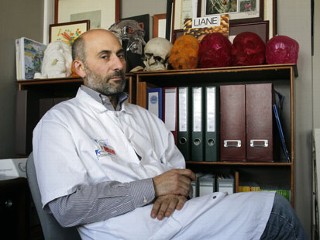
The surgery was performed in France on a man whose face was so deformed by "Elephant Man" disease that he consistently shocked passersby on the street. Doctors say the procedure holds promise for the 200-400 badly burned American GIs awaiting similar help in US military hospitals.
Face transplants have been a reality for a few years now, but the French surgical team went a step further and successfully included the eyelids, the whole lachrymal system, which produces tears, as well as the mouth.
The transplant took place on June 27 at the Henri Mondor public hospital in Créteil, outside Paris. The patient, who lives in the Paris region and was identified only as Jérôme, was suffering from a neurofibromatosis, a genetically-inherited disorder also known as "Elephant Man" disease, which had been deforming his face for years. He could no longer go out on the street without horrifyng others.
"What is important is that we were able to include the eyelids in the transplant. It's not just a piece of skin, but it's the whole eyelids, including the tears ducts," said Laurent Lantieri, MD, the surgeon who performed the 12-hour operation with 10 other doctors and nurses. He told ABC News by telephone, "The patient is doing very well today. He can walk, eat, he still has some difficulties to speak because he had a tracheotomy, meaning he had a tube in his windpipe and it's a bit swollen."
As is typical in any face transplant, the patient's body is likely to reject his new face although he has not experienced a rejection so far, doctors said. A rejection will be treated with immunosuppressant medication.
"He gave me the thumps up," said Lantieri of the patient's reaction when he saw his face in the mirror for the first time after the operation. "He is very grateful."
"The most difficult part of the operation was to connect the tear duct that goes through the bone," Lantieri explained. "We had to develop a method to be able to accomplish this."
The recent surgery marks the first successful operation of its kind. Lantieri and his team performed a similar transplant on a badly burned patient a year ago, but the patient died of complications. "We transplanted the face and both hands to this patient," he recalled. "Today, we've resolved the problems we did not think we would have encountered at the time."
Lantieri and his team have performed five out of the 13 full or partial face transplants the world has seen so far, including in the U.S.
In March, a team of doctors in Barcelona, Spain, performed the same type of operation on a man in his 30s who received new facial muscles, skin, nose, lips, jaw, teeth, palate and cheekbones, but no eyelids.
"This is something that had not been done before (to include the eyelids)" Lantieri said. "Only our team has the ability to do such thing," Lantieri said, rejecting the idea of competition between the different teams."What matters is that patients are treated well," he said.
In November 2005, Isabelle Dinoire,38, became the first person ever to receive a partial (lips, nose, chin) face transplant in Amiens, northern France. In December 2008, Connie Culp, 45, received a face transplant for the first time in the United States at the Cleveland Clinic.
"American doctors are perfectly able to perform these type of operations," Lantieri said, adding that a team of American doctors from New York, Baltimore and Rochester came to France last week to learn the surgical technique from Lantieri and his team. "Something needs to be done for the 200 to 400 badly burned GIs who are waiting in U.S. military hospitals to be treated with such procedure," he added.
Other medical teams, including an American and a British, have received official authorizations to carry out full face transplants.



Reader Comments
to our Newsletter